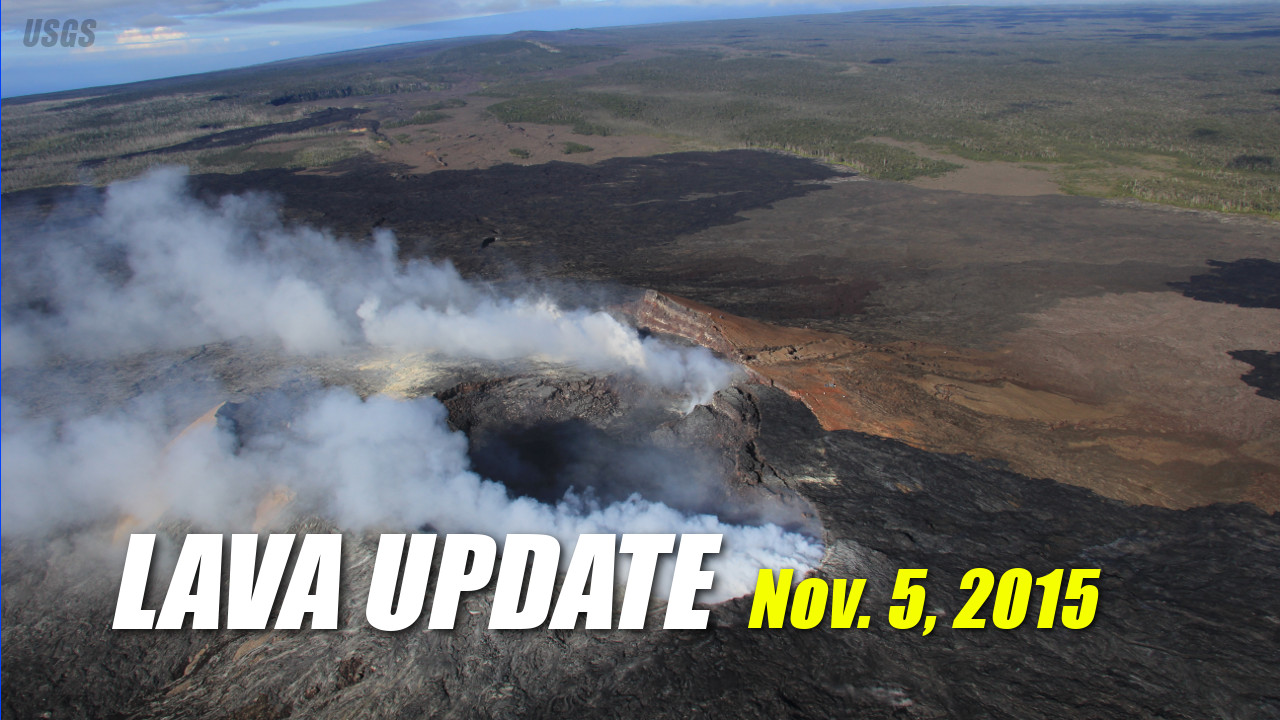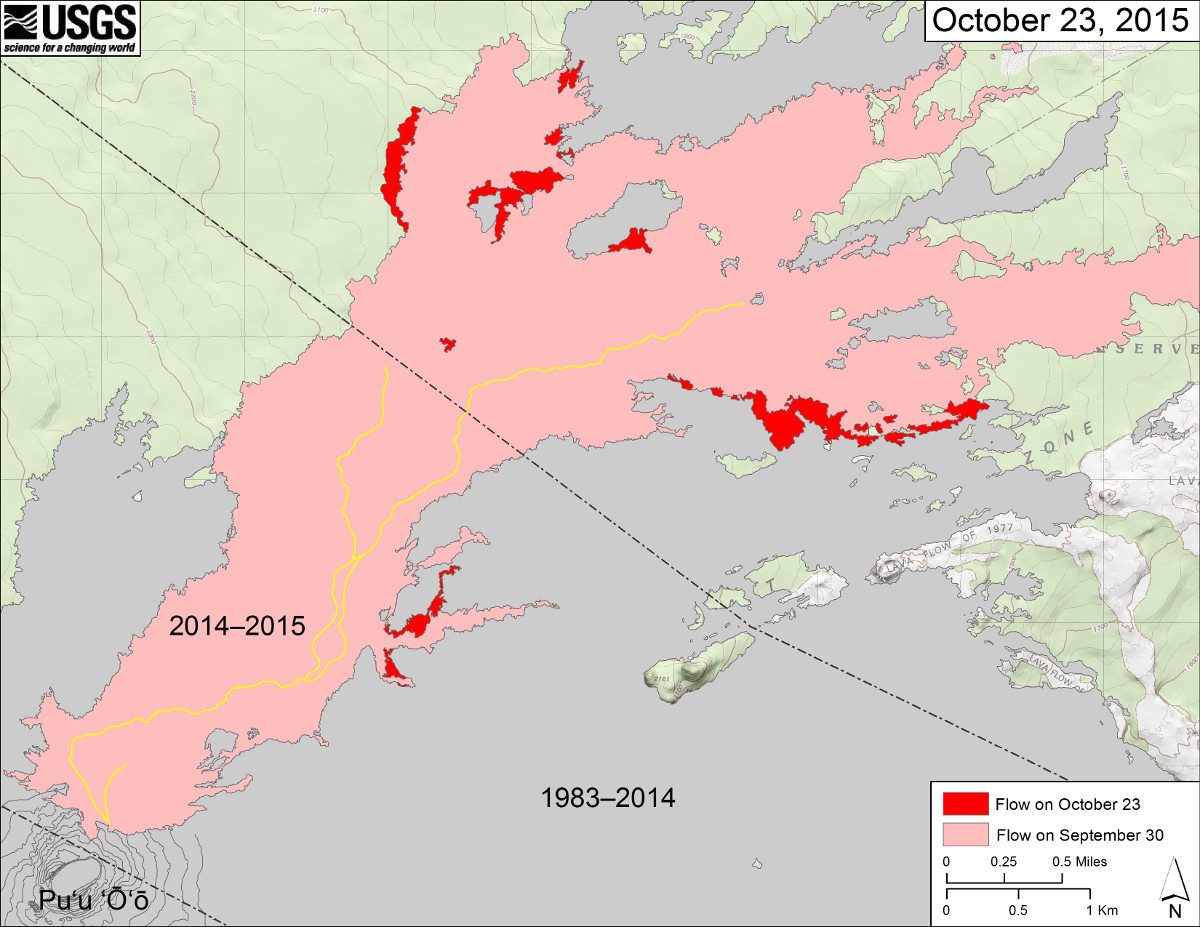
ABOVE: The fume-filled crater at Puʻu ʻŌʻō is in the foreground, and the vent for the June 27th lava flow is just out of view of the lower right corner of the photo. (courtesy USGS)
NEWS BRIEFS
- There is no lava flow threat to nearby communities.
- A swarm of approximately 20 small earthquakes occurred on Mauna Loa’s West Flank this week. Mauna Loa volcano is not erupting.
- The inflationary tilt at Kilauea’s summit continues. The lava lake level has risen to 148 feet below the Overlook crater rim this morning.
MAUNA LOA VOLCANO UPDATE
WEEKLY MAUNA LOA STATUS UPDATE
November 5, 2015On Thursday, September 17, the Volcano Alert Level and Aviation Color Code for Mauna Loa was elevated to Advisory/Yellow based on long-term trends in both earthquake and deformation monitoring data.
Activity Summary: Mauna Loa is not erupting. A swarm of approximately 20 small earthquakes occurred on Mauna Loa’s West Flank at a depth of approximately 8 km (5 mi). Earthquakes occurred beneath Mauna Loa’s upper Southwest Rift Zone at rates greater than background but below earthquake rates recorded over the summer of 2015. Deformation data remain consistent with inflation of magma reservoirs beneath Mauna Loa’s summit and upper Southwest Rift Zone.
KILAUEA VOLCANO UPDATE
KILAUEA STATUS UPDATE
November 5, 2015Activity Summary: Eruptions continue at Kīlauea Volcano’s summit and in its east rift zone at Puʻu ʻŌʻō. The summit is showing inflationary tilt and the lava lake level is roughly 45 m (148 ft) below the Overlook crater rim. Scattered breakouts remain active northeast of Puʻu ʻŌʻō, within about 7 km (4 miles) of the vent. There is no lava flow threat to nearby communities.
Summit Observations: The inflationary tilt at Kilauea’s summit continues. Consistent with the inflationary tilt, the lava lake level has risen to roughly 45 m (148 ft) below the Overlook crater rim this morning. During the past day, intermittently high tremor and associated spattering activity at the lake’s surface has been occurring. Summit sulfur dioxide emission rates averaged 3,400 metric tons per day for the past week.
Puʻu ʻŌʻō Observations: Web cam images this morning show no significant change in eruptive activity within the crater. Tilt measured at Pu’u ‘Ō’ō shows inflation, presumably in response to inflation at the summit of Kīlauea. The sulfur dioxide emission rate from all East Rift Zone vents was about 150 metric tons per day when last measured on October 21, 2015.
June 27th Lava Flow Observations: This morning, webcam images show that scattered breakouts remain active between about 2.2 and 6.4 km (1.4 and 4 mi) northeast of Puʻu ʻŌʻō. There is no lava flow threat to nearby communities.
RECENT MAPS

This USGS map shows recent changes to Kīlauea’s active East Rift Zone lava flow field. The area of the flow on September 30 is shown in pink, while widening and advancement of the flow as of October 23 (based on satellite imagery and ground mapping) is shown in red. The yellow lines show the active lava tube system. Puʻu ʻŌʻō lava flows erupted prior to June 27, 2014, are shown in gray.

This small-scale USGS map shows Kīlauea’s active East Rift Zone lava flow in relation to the eastern part of the Island of Hawaiʻi. The area of the flow on September 30 is shown in pink, while widening and advancement of the flow as of October 23 is shown in red. The yellow lines show the active lava tube system. Puʻu ʻŌʻō lava flows erupted prior to June 27, 2014, are shown in gray. The black box shows the extent of the accompanying large scale map. The blue lines show steepest-descent paths calculated from a 1983 digital elevation model. Because the flow field is changing very little at the moment, mapping of the lava flow is being conducted relatively infrequently.


by Big Island Video News11:20 am
on at
STORY SUMMARY
Today's Kilauea and Mauna Loa volcano activity report, includes recent maps and imagery.